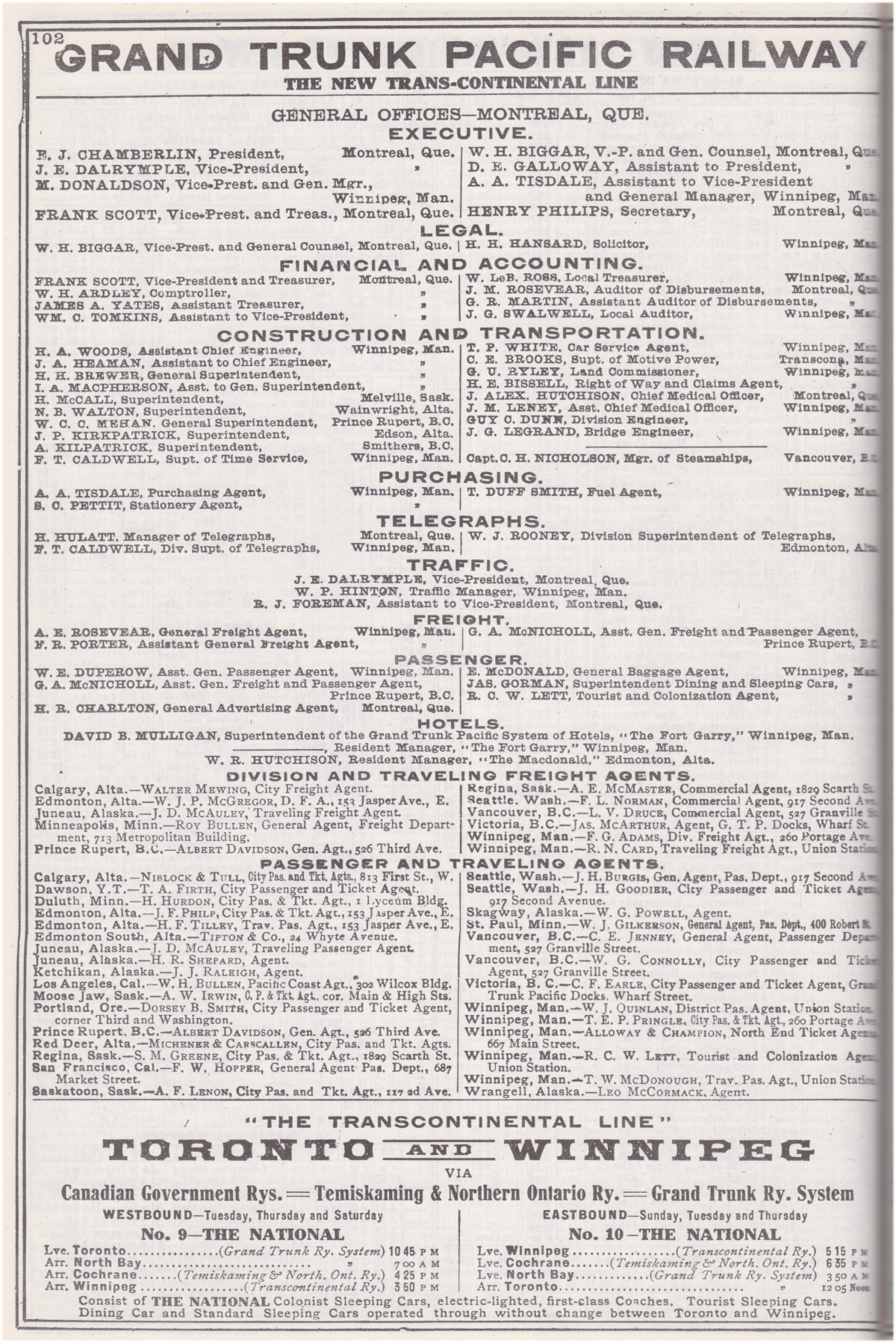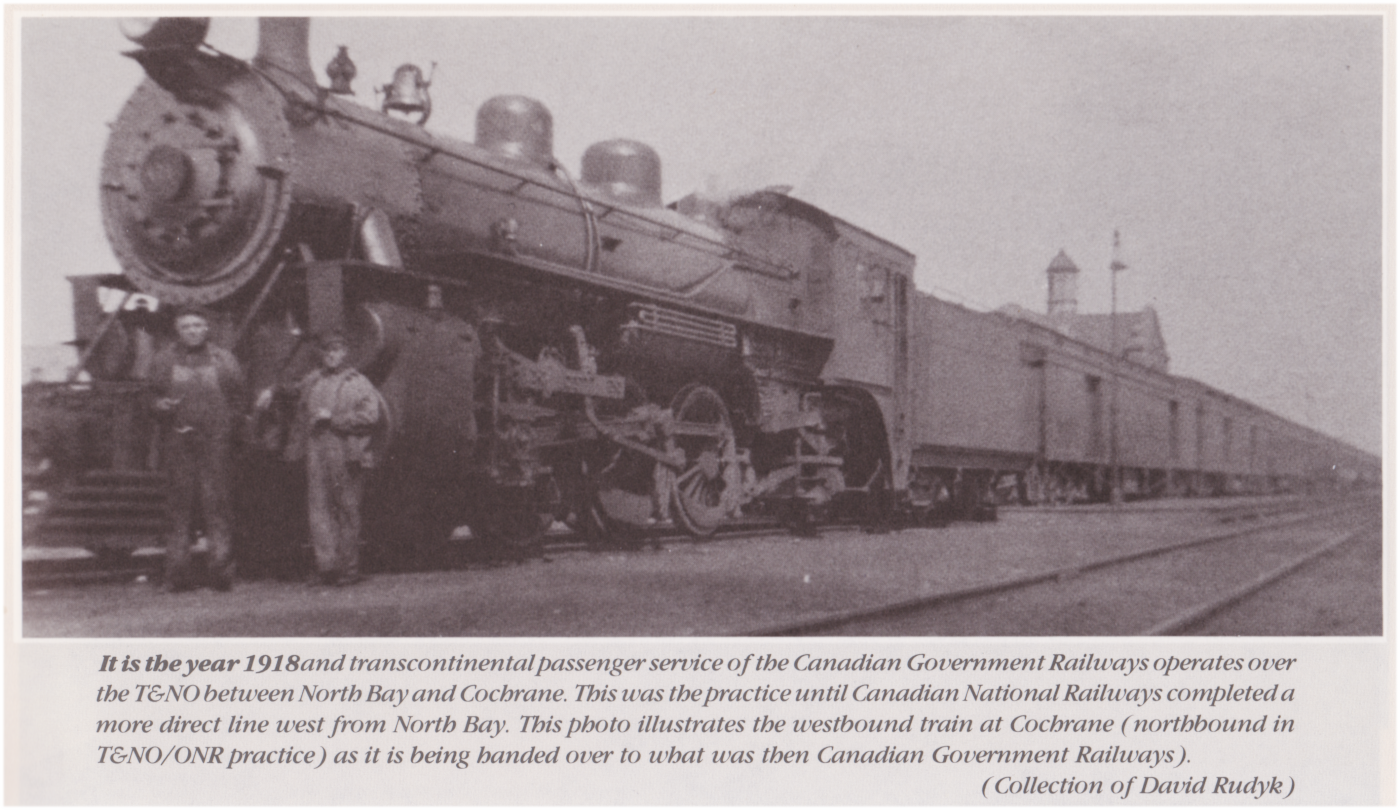In case you haven't noticed, there's a lot that I don't know. While preparing the 'Notes by the Way' from the circa 1920 National Transcontinental booklet I came upon this entry for Cochrane.

* * *
For some time I have had this (below) 1921 'The National Way' booklet covering all the CNR lines - west-to-east. I assumed it was just branding the Canadian National way - a branding thing for the nationalized railways of which all Canadians could be proud. The title page and the inside cover are shown below.

In checking four books about the T&NO/ONR ... only one book provided any detail about the GTR running rights arrangements with the T&NO. Another presented only a very interesting photo of what The National actually looked like.
 |
| from: The Railway Builders; Oscar D Skelton; 1916; Glasgow Brook & Co. |
Above: The Grand Trunk in 1914.
The T&NO (the dotted blue line running north from North Bay) reached Cochrane by the summer of 1909. This was helpful for the building of the National Transcontinental through the bush of northern Quebec and Ontario. Before 1909 in practical terms - rails, bridge girders, cement and other construction supplies could only be shipped west via Quebec City.
On the map above, the railway lines shown in red are the Grand Trunk's southern network. The NTR (which the GTR was supposed to lease and operate after it was completed by the Canadian government) is seen between Moncton and Winnipeg. The Grand Trunk Pacific is shown in blue to the west of Winnipeg.
The Grand Trunk arranged running rights over the T&NO - North Bay to Cochrane - because its original southern network (red) was otherwise not contiguous with the NTR ... and its Grand Trunk Pacific being built west from Winnipeg to Prince Rupert.
* * *
The following images come from the June 1916 edition (reprint) of the Official Guide ...
(It is several inches thick and it asked me to tell you it does not like to be scanned.)
Above, you can see The National is featured right under the officers and offices
of the Grand Trunk Pacific back in June 1916.
Additional specific timetables are included from the same copy of the Official Guide, below.
* * *
Below, you can see a detailed schedule from Toronto to North Bay for Trains 9 & 10.
This train runs three days per week.
You must go all the way to the extreme bottom right to see the # reference mark decoded. On other pages, to decode reference marks, you must be as resourceful as the Official Guide typesetters ... reference marks are often printed in spare column spaces ... at a 90 degree angle to the rest of the text.
* * *
Trains 9 & 10 operate over T&NO rails, below ...
* * *
Trains 9 & 10 operate Cochrane to Winnipeg on that segment of the NTR/CGR ...
* * *
With a few hours' margin, presumably for switching, inspection, restocking, recrewing, etc
Trains 9 & 10 connect with GTP Trains 1 & 2 at Winnipeg ...
As you have just seen, in 1916, the GTR/T&NO/CGR operated a train from Toronto, via Cochrane to Winnipeg with limited stops. It connected with the premier Grand Trunk Pacific train running between Winnipeg and Prince Rupert.
Probably, the Toronto-Cochrane-Winnipeg train was 'competitive' in some ways with the existing CPR service between those two locations in 1916. Or, at least, it tried to be.
If you were serious about getting from Montreal or Toronto to the Pacific coast ... and you intended to board a steamer for Asia ... you'd probably opt for the CPR routing. The GTP would be quick to point out that Prince Rupert was closer to Asia - considering the curvature of the earth. However, the CPR service had been well-established for almost 30 years by that time.
* * *
More on the Grand Trunk, T&NO Arrangements
The Grand Trunk had negotiated its trackage rights with the T&NO in 1911. According to Steam into Wilderness (Albert Tucker; 1978; Fitzhenry & Whiteside, P.73) the GTR paid $550,000 in annual rent and maintenance charges to the T&NO (about $12.4 million in 2020 dollars). I assume this covered both freight and passenger trains of the Grand Trunk heading for Winnipeg and points west, and the reverse.
In addition to the extra income from the GTR, another benefit to the T&NO of having The National operating over the T&NO was that it was a transcontinental train running on what was just a regional railway. As the T&NO's territory attracted various titans of industry, coming in to inspect their mining and forest products properties along the line, it didn't hurt to offer them a through train with nice equipment.
By 1919, The National was providing 30% of the T&NO's passenger earnings over and above the rental and maintenance charges previously mentioned.
In 1919, the fledgling Canadian National Railways needed to start cutting the costs racked up by its constituent railways. It had its own perfectly good Toronto to Winnipeg route - Mackenzie and Mann's former CNoR - via Capreol, Fort William and Fort Frances. Why should the CNR pay fees to the T&NO for The National ?
Well ... because! T&NO Chairman JL Englehart escalated the issue to Premier Hearst. The latter contacted acting Prime Minister White with a copy also sent to JD Reid (who had replaced Frank Cochrane as Minister of Railways and Canals ... as we play railway place name bingo).
... Cowed by the Conservative politicians in Toronto and Ottawa joining forces, the CNR would continue to run The National through Cochrane for the moment. My 1921 booklet would be printed.
See the Map Below ...
But the writing was on the wall ... because the surveyors had been in the field ... performing trial and location surveys for the Nakina-Longlac cutoff in 1919. The cutoff began operating in 1923 and at some point the passenger trains joined the freights to use it ... spelling the end of the Toronto-Cochrane-Winnipeg routing.
Below are a couple of images from the time that The National was still running ...
The locomotive above may be Canadian Government Railways 473.
Built by Montreal Locomotive Works in 1918, serial 58332.
Renumbered CNR 5095, reference: Clegg & Corley P 99.
Scrapped: October 1961.
Below is a map from that time in history
when one could still travel ...
The National Way.
 |
| from: Canada, Pacific to Atlantic; Canadian National/Grand Trunk; 1921. |






